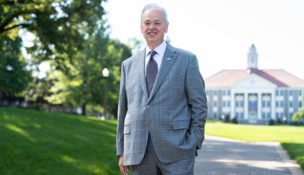Solving a math problem
Sweet Briar still must ‘get students and get funds’ to survive
Gary Robertson //October 29, 2015//
Solving a math problem
Sweet Briar still must ‘get students and get funds’ to survive
Gary Robertson //October 29, 2015//
Sweet Briar College’s rescue by its alumnae sparked national headlines in June, with television crews and print journalists descending in droves on the 3,250-acre Amherst County campus just north of Lynchburg.
Now, the future of the 114-year-old women’s college becomes a math problem.
President Philip Stone, who was officially installed Sept. 25 after the resignation of his predecessor and the college’s board, says that to remain in business and balance the books Sweet Briar must increase its enrollment to about 800 students in the next few years. That would represent the largest number of students in the college’s history.
Sweet Briar’s on-campus enrollment in September was 248, including a thin freshman class of 38. But college officials point out that, after Sweet Briar’s closing was announced in March, recruitment efforts ceased, and a number of Sweet Briar students transferred to other schools. Recruiting now has resumed with intensity.
The college’s previous administration cited declining enrollment as one of the reasons for closing the school. The number of students on campus had dropped to 561 last year, a 14 percent drop over six years.
Stone has a good track record for improving enrollment. He was president of Bridgewater College from 1994 to 2010, and in his first 10 years on the job enrollment grew by 78 percent.
Besides increasing its student body, Stone says Sweet Briar also must raise more money to strengthen its endowment, which currently totals about $68 million, while reducing annual withdrawals from 10 percent to 5 percent of its value.
In addition, the school must cut expenses other than salaries by 20 percent.
The college also must keep its eye on its debt. A liquidity provision in its bonds requires that Sweet Briar’s expendable resources exceed its debt by a margin of 10 percent on June 30, the end of its fiscal year. In other words, the college must have $1.10 for every $1 of debt to avoid triggering a bond default. Expendable resources include almost any asset that is not permanently restricted, such as certain endowment funds, college officials say.
Stone points out that the college has a cushion, thanks to a ruling by Virginia Attorney General Mark Herring. In June, Herring consented to the release of restrictions on $16 million from the college’s endowment for ongoing operations.
Sweet Briar has a current outstanding bond debt of about $25 million. Stone says the college has never missed a payment on its bond debt and does not intend to.
An improbable year
The saga of Sweet Briar College could make a movie, and perhaps it will. College officials are creating a marketing campaign that will chronicle its improbable year.
Stone, a lawyer, has had a remarkable year of his own. He never applied to be Sweet Briar’s president. Interested parties called him out of the blue, after hearing that he would be willing to help out.
“Do you think you can save this place?” one caller asked. “I will do it,” Stone recalls saying, in accepting the job at the age of 72.
When he started work at the college on July 3, “I had no senior staff remaining and urgent business to take care of,” Stone says. Sweet Briar’s highly popular study abroad program had been shifted to another women’s college; so had its nationally known equestrian program. They have since been returned to the college.
Stone received 1,800 emails during his first week in office. He has a simple strategy for saving Sweet Briar: “Get students and get funds.”
The previous administration announced in March that it was closing the college at the end of August because of what it described as insurmountable financial problems. Among other factors, it cited a trend away from women’s colleges, especially those in rural areas like Sweet Briar.
To increase enrollment, Stone says, one strategy will be to seek international students, targeting parents who can afford to pay for an American education but also favor their daughters being in a peaceful, rural environment.
Passionate alumnae
Stone praises the college alumnae, who formed a group called Saving Sweet Briar to prevent the college from closing. After a series of legal battles, the alumnae prevailed in mediated negotiations to keep the school open at least one more academic year.
Alums raised $12 million in cash in about 100 days, while gathering pledges totaling $29 million that will be paid over several years.
Teresa Pike Tomlinson, a fiery Sweet Briar alumna (Class of ’87) who is mayor of Columbus, Ga., now chairs the college’s new board of directors. “We have found a tremendous untapped capacity among Sweet Briar alumnae,” she says, citing their resources and passion to see the school survive.
Tomlinson says Sweet Briar graduates inspired many people with their tenacity, carrying out sophisticated legal and fundraising efforts to keep the school’s doors open.
“It’s been a topic of conversation not only in Virginia but all across the country. We’re all rooting for Sweet Briar to have success,” says Robert Lambeth, president of the Council of Independent Colleges in Virginia.
Sweet Briar alumnae have responded not only with their pocketbooks, but also with a lot of elbow grease. Hundreds descended on the campus during the summer to clean, paint and wash the buildings.
Some alums even volunteered to teach. One of them is Leigh Ann White (Class of ’86), who joined the economics department as a visiting assistant professor. Until June, she was an executive with Cambridge, Mass.-based Biogen, a major biotech company.
White holds a master’s degree in demography from Georgetown University and earned her doctorate in health economics and health policy at Johns Hopkins University. “I just loved going to Sweet Briar, and I wanted to save the college,” she says. “It seemed like something I needed to do. It mattered.”
Amelia Currin, a freshman from North Carolina, is among the small group of students who, against all odds, enrolled in the college this year. “I have witnessed a powerful group of women rise up in the form of Saving Sweet Briar and leverage their clout to overcome insurmountable odds. Who would not want to stand strong among their ranks?” Currin asks.
Stone says the passion of people like Currin and White will help the college get back on its feet. “We want to make history together,” he says.
r
















